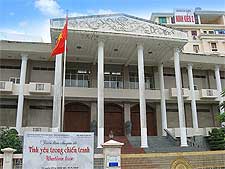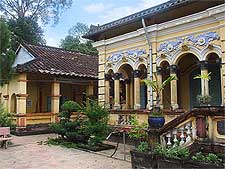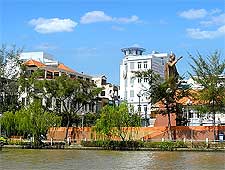Can Tho History Facts and Timeline
(Can Tho, Mekong Delta, Vietnam)

Can Tho is amongst the largest cities within the region of the Mekong Delta, with a population of more than one million people. However, it retains a certain rural charm, which visitors can experience by joining one of the many floating-market tours.
Visitors also have a good chance to learn more about local history and culture at the Can Tho Museum on DL Hoa Binh. The city has had to overcome periods of foreign rule, as well as attacks by foreign forces, ever since its founding in 1739. Despite these difficult times in Can Tho history, it has a reputation as one of the friendliest cities in Vietnam, offering a warm welcome to all visitors.
Tran Giang Era
Can Tho was first established as Tran Giang in 1739, under the stewardship of Mac Thien Tich, the son of governor Mac Cuu who passed away in 1735. Mac Cuu arrived here from Guangdong,
China, quickly establishing a palace under Lord Nguyen Phuc Chu and encouraging further settlement.
As the century progressed, Tran Giang became an important fort, especially during fierce battles for the territory in the 1770s and 1780s. This era also saw the construction of the most interesting architecture in local history. The Guangzhou Assembly Hall was built at the end of the 1800s on the banks of the Can Tho River, in homage to the Chinese Kuang Kung deity.

Phong Phu Era
The area on which Can Tho stands was renamed several times under the Nguyen leadership, as a result of boundary changes. In 1839, the area came under the Phong Phu district, a place which was well-known for its peace and prosperity.
This began one of the most stable periods in the history of Can Tho, as more people arrived to settle on the banks of the Mekong River. Boats were the main form of travel and settlers set up the first of the floating markets, which can still be seen today.

Colonial Rule
In 1867, the French broke the 1862 peace treaty, allowing them to occupy three eastern provinces. They subsequently took over the western provinces as well, of which Phong Phu was a part. Can Tho was officially named as a district ('arrondissement') by the French in 1876.
The city remained Can Tho until the French left the region in 1954, while it was also renamed Phong Dinh during the period under the South Vietnam government of the 1960s and 1970s. The city's name reverted back to Can Tho once again, on its reunification in 1975.
The American forces built a small airport (Tra Noc) in 1965 and this remained a regional airport for many years. However, rampant economic growth in the Mekong Delta led to the eventual inauguration of Can Tho International Airport in 2011.
 Can Tho is amongst the largest cities within the region of the Mekong Delta, with a population of more than one million people. However, it retains a certain rural charm, which visitors can experience by joining one of the many floating-market tours.
Can Tho is amongst the largest cities within the region of the Mekong Delta, with a population of more than one million people. However, it retains a certain rural charm, which visitors can experience by joining one of the many floating-market tours.
